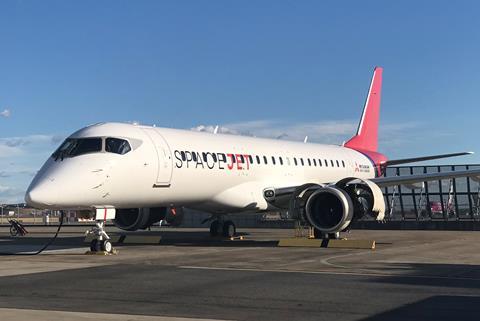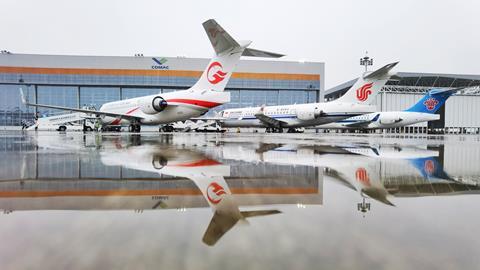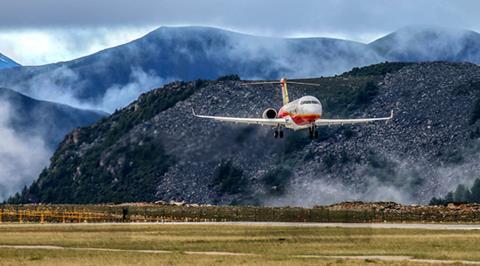In the middle of 2020, as most of the world was convulsing between lockdowns, two Asian aircraft manufacturers each made major announcements relating to their key programmes.
In May, Mitsubishi Aircraft of Japan delivered sobering news: the annual budget for its flagship SpaceJet regional aircraft programme was to be halved, amid fresh delays to the clean-sheet jet.

In all, the SpaceJet was allocated just Y60 billion ($569 million) for the current financial year, amid widening losses on the programme.
Just over a month later, the positive news from neighbouring China was in stark contrast.
On 29 June, Shanghai-based airframer Comac trumpeted the fact that examples of its ARJ21 regional jet had been delivered to China’s ‘Big Three’ airlines – Air China, China Southern Airlines and China Eastern Airlines.
The trio of ARJ21s made for a picture-perfect moment, adorned in the easily recognised liveries of two of the carriers, save for that of China Eastern, which instead was painted in the colours of regional subsidiary OTT Airlines.
It was a long time coming for Comac, which has always hoped to give the ARJ21 greater visibility in its home market.
Its optimism when at the milestone could barely be concealed: hailing what it called “the official entry of the ARJ21… into mainstream international airline fleets”, Comac was quick to add that the ARJ21 will “play a positive role” in the promotion of regional aircraft operations.

Indeed, the two key announcements of May and June highlight the diverging fortunes of Comac and Mitsubishi Aircraft, and that they seem to be drifting ever further apart.
SPACEJET HITS SEVERE TURBULENCE
But Mitsubishi Aircraft’s recent history has been written via a steady drip-drip of bad news. The Japanese airframer began the year on a low note, announcing in February, days before it was due to participate in the 2020 Singapore air show, that it expected the first SpaceJet delivery to be delayed by a year or more. That milestone is now expected in April 2021 at the earliest, and potentially beyond March 2022.
Launch customer All Nippon Airways was due to have received its first Pratt & Whitney PW1200G-powered SpaceJet M90 in the middle of this year.
In March, as the pandemic forced the adoption of social-distancing measures, Mitsubishi Aircraft’s SpaceJet M90 flight-test vehicle 10 took off for a muted, low-key maiden sortie.
After its major announcement in May about budget cuts and fresh delays, Mitsubishi Aircraft dropped yet another bombshell - it was to close all non-Japan locations, and move SpaceJet activities back to its Nagoya headquarters.
As part of the consolidation to Japan, the company halted flight testing of its 90-seat SpaceJet M90 variant and suspended development of its 76-seat M100.
An organisational shake-up ensued with two high-profile executives departing: chief development officer Alex Bellamy, and global marketing and strategy head Steve Haro.
Mitsubishi Aircraft told FlightGlobal that the reorganisation meant it had to make “some very difficult decisions, as well as implement the change from global development activities to activities of appropriate scope”.

Financially, the SpaceJet programme has also proved to be a poisoned chalice for parent company Mitsubishi Heavy Industries (MHI). For the quarter ended 30 June, the SpaceJet programme made a loss of Y68.8 billion. Although that was mainly driven by impairment charges related to the acquisition of the CRJ regional jet programme from Bombardier, another Y20 billion of development costs did not help.
SpaceJet-related losses pulled MHI into the red, as the parent company sank to a loss of Y71.3 billion for the quarter.
The aircraft, defence, and space unit, in which the SpaceJet programme resides, emerged as one of the worst-hit segments from the coronavirus outbreak, as it tumbled to a steep first-quarter loss of Y62 billion, reversing the Y9.4 billion profit it made in the same period last year.
COMAC SOARS ON POST-PANDEMIC HIGH
As for Comac, its fortunes in 2020 could not be any more contrasting. More specifically, the fate of its ARJ21 programme continued its upward climb.
The airframer was forced to suspend operations in February, as China battled the coronavirus outbreak.
But just a month later, Comac announced the opening of a second ARJ21 production line at its Shanghai base, co-located at the same facility where its C919 narrowbody programme is assembled. It was also the same month that it restarted production at its sites.
In April, it made its first post-shutdown delivery, an ARJ21 that went to Chengdu Airlines. It was the 24th ARJ21 to be handed over, and the first to be assembled at its Pudong production line.

In addition, Comac has managed a rare feat this year by adding to its backlog: in June, Guizhou-based China Express Airlines signed a partnership framework agreement for the purchase of 100 ARJ21 and C919 aircraft.
Cirium fleets data shows that as at 30 September, Comac has delivered 12 ARJ21s to Chinese carriers this year. Of these, 10 are in service, while two are in storage. Two further handovers are scheduled this month, which should help the airframer towards its 30-unit year-end target.
Details on Comac’s other development programmes remain scant, however. Test flights of the C919 narrowbody – powered by CFM International Leap-1C engines – are continuing using a six-strong fleet, but no firm dates for certification or service entry have been revealed. In addition, China continues to work on an indigenous powerplant for the jet, the ACAE CJ-1000AX.
As for the CRAIC CR929 widebody, which is being jointly developed with Russia’s United Aircraft, Comac adds that it hopes to complete “optimisation of composite structural parts” by year-end. However, reports of serious differences between the partners, plus an apparent lack of progress on supplier selection, do little to instil confidence in the project. First delivery now appears to have shifted to 2028-2029, from 2025 previously.
How commercial airliner programmes and their manufacturers have dealt with crisis
- 1
- 2
- 3
 Currently reading
Currently readingAsian airframers tread diverging paths through the crisis
- 4
- 5
- 6































